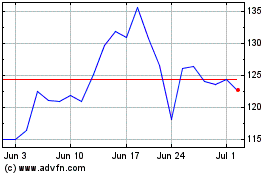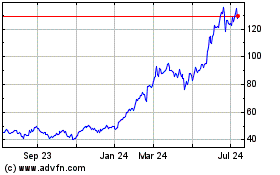By Gunjan Banerji
Stocks, government bond yields and commodities fell in a wild
session Friday as anxieties over trade relations with China sparked
fresh worries about global growth and the potential for a
recession.
The Dow Jones Industrial Average dropped 623.34 points, or 2.4%,
after China said it would impose retaliatory tariffs on additional
U.S. products and President Trump vowed on Twitter to respond. The
yield on the benchmark 10-year U.S. Treasury note settled at the
lowest level since August 2016, and copper prices tumbled to their
lowest mark since May 2017.
Shares of toy makers, retailers and semiconductor companies that
manufacture products in China were among the hardest hit. Mattel
and Hasbro both dropped more than 6%, while Advanced Micro Devices
and Nvidia fell at least 5%.
The developments marked an escalation of trade tensions between
two of the biggest global economies, stoking waves of selling in
the stock market and continuing a stretch of turbulence in August.
Markets have been punctured by bouts of volatility, driven by the
trade tensions, uncertainty about the pace of the Federal Reserve's
interest-rate cuts and concerns about economic growth around the
world.
"It seems as though it's a freaky Friday," said Michael Arone,
chief investment strategist at State Street Global Advisors. "It
looks as though the markets are bracing for the worst."
The drop marked the Dow industrials' third decline of at least
2% this month and put the blue-chip index 6.3% below last month's
all-time high. The index is still up nearly 10% this year.
Meanwhile, a measure of stock volatility, the Cboe Volatility
Index, jumped about 19% to 19.87 after falling earlier in the
week.
The S&P 500 dropped 75.84 points, or 2.6%, while the Nasdaq
Composite shed 239.62 points, or 3%. All three major indexes have
declined for four consecutive weeks.
This past week's trading activity was marked by mixed signals
about the economy and prospects of stimulus ahead. President Trump
weighed in several times with criticism of the Fed's approach and
seemingly conflicting comments about implementing fresh tax cuts to
boost the economy.
Still, investors said trade remains one of their biggest
concerns, and that was on display Friday. Stock futures overnight
Thursday into Friday pointed to gains but slumped when China rolled
out the new plan for tariffs.
Investors digested that news and even briefly pushed major
indexes higher following Federal Reserve Chairman Jerome Powell's
comments about the future of interest-rate policy. But stocks
reversed course again, diving after President Trump's tweets
ordering U.S. companies to seek alternatives to doing business in
China. The losses accelerated heading into the closing bell.
"The timing of it is remarkable," said John Brady, managing
director at futures brokerage R.J. O'Brien & Associates, of the
trade news early Friday. "It puts tariffs front and center on a
very important day for markets."
After the stock market closed Friday, Mr. Trump tweeted that
China shouldn't have put new tariffs on U.S. products and added
that he was increasing the level of tariffs of Chinese goods.
The trade developments overshadowed a highly anticipated speech
from Mr. Powell in Jackson Hole, Wyo. Ahead of the speech, many
investors suggested his comments would be the biggest event of the
day, with the potential to stoke big moves across stock, bond and
currency markets. Instead, market reaction was muted.
Mr. Powell acknowledged trade in his comments, saying the
uncertainty was "playing a role in the global slowdown" and adding
the Fed would act accordingly to "sustain the expansion."
But the comments again drew the ire of President Trump, who said
in a tweet that "the Fed did NOTHING."
Investors are next looking to the Group of Seven summit in
France, which could also highlight divisions between world leaders.
They will also parse figures on consumer spending and a second
estimate of second-quarter gross domestic product for signals about
the state of the economy.
In one sign of anxiety percolating through markets, a bond
market signal -- the yield curve -- has flashed a warning that a
potential recession is looming. The two-year Treasury yield settled
above the 10-year Treasury yield Friday, according to Dow Jones
Market Data. The curve has inverted ahead of the past seven
economic recessions, making it a widely watched measure.
Investors have also been analyzing news from the Fed as well as
fresh economic data, some of which have sent conflicting signals
about the state of the economy. A series of weak manufacturing data
earlier this past week around the world also raised concerns about
a possible recession, while other figures have elicited
optimism.
Strong earnings reports from retailers like Target and Lowe's
have offered encouraging signs about the strength of the U.S.
consumer.
"There's really been a tug of war in the markets," said Chris
Zaccarelli, chief investment officer at Independent Advisor
Alliance. "I don't think the worst is behind us."
Mr. Zaccarelli said he has recently bought shares of
consumer-staples companies, a sector that tends to fare better when
the economic outlook deteriorates.
Investors scooped up traditionally safer assets like government
bonds and gold Friday, sending the yield on the 10-year Treasury
note down for the fourth consecutive week to 1.523% Friday, from
1.613% Thursday. Yields fall as bond prices rise.
Gold prices notched gains for the fourth consecutive week,
hitting their highest settlement value in more than six years on
Friday. The WSJ Dollar Index fell about 0.4% to 90.90. Lower
Treasury yields can make the U.S. dollar less attractive to income
seeking investors around the world.
Though major U.S. stock indexes are still hovering near their
recent highs, the back-and-forth between U.S. and China led some
analysts to say that they weren't expecting a speedy resolution
between leaders of the two countries, and that they were bracing
for more turbulence.
"This is going to be ping-pong for a while," said Sean O'Hara,
president of the ETF division at Pacer Financial Inc. "That's what
we're going to continue to see until we get a resolution, if we
ever do. It's probably going to drive the short-term ups and downs
of the market."
Write to Gunjan Banerji at Gunjan.Banerji@wsj.com
(END) Dow Jones Newswires
August 23, 2019 18:42 ET (22:42 GMT)
Copyright (c) 2019 Dow Jones & Company, Inc.
NVIDIA (NASDAQ:NVDA)
Historical Stock Chart
From Mar 2024 to Apr 2024

NVIDIA (NASDAQ:NVDA)
Historical Stock Chart
From Apr 2023 to Apr 2024
